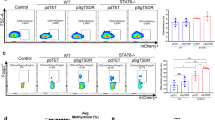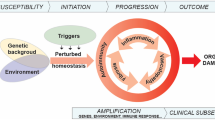Abstract
Oral lichen planus is a chronic inflammatory disorder of the oral mucosa that represents T cell-mediated autoimmune diseases. The regulation and roles of carcinoembryonic antigen-related cellular adhesion molecule 1 (CEACAM1), a novel immune molecule, in the immunopathogenesis of T cell-mediated autoimmune diseases remain unclear. In the current paper, CEACAM1 was found to be overexpressed in peripheral T cells and epithelial cells in oral lichen planus patients. A fraction of infiltrating inflammatory mononuclear cells in the lamina propria of the oral lichen planus mucosa also expressed CEACAM1. Importantly, for the first time, CEACAM1 expression in T cells and in normal human oral keratinocytes was demonstrated to be regulated differently by osteopontin in vitro. Furthermore, the apoptosis of oral keratinocytes and activated T cells can be markedly suppressed by CEACAM1-specific monoclonal antibodies. In conclusion, OPN-regulated CEACAM1 expression may play a critical role in the immunopathogenesis of oral lichen planus.








Similar content being viewed by others
References
Iijima W, Ohtani H, Nakayama T, Sugawara Y, Sato E, Nagura H, et al. Infiltrating CD8+ T cells in oral lichen planus predominantly express CCR5 and CXCR3 and carry respective chemokine ligands RANTES/CCL5 and IP-10/CXCL10 in their cytolytic granules: a potential self-recruiting mechanism. Am J Pathol. 2003;163:261–8.
Zhou ZT, Wei BJ, Shi P. Osteopontin expression in oral lichen planus. J Oral Pathol Med. 2008;37:94–8.
Khan A, Farah CS, Savage NW, Walsh LJ, Harbrow DJ, Sugerman PB. Th1 cytokines in oral lichen planus. J Oral Pathol Med. 2003;32:77–83.
Sugerman PB, Savage NW, Walsh LJ, Zhao ZZ, Zhou XJ, Khan A, et al. The pathogenesis of oral lichen planus. Crit Rev Oral Biol Med. 2002;13:350–65.
Cortes-Ramirez DA, Gainza-Cirauqui ML, Echebarria-Goikouria MA, Aguirre-Urizar JM. Oral lichenoid disease as a premalignant condition: the controversies and the unknown. Med Oral Patol Oral Cir Bucal. 2009;14:E118–22.
Kim SG, Chae CH, Cho BO, Kim HN, Kim HJ, Kim IS, et al. Apoptosis of oral epithelial cells in oral lichen planus caused by upregulation of BMP-4. J Oral Pathol Med. 2006;35:37–45.
Santoro A, Majorana A, Bardellini E, Gentili F, Festa S, Sapelli P, et al. Cytotoxic molecule expression and epithelial cell apoptosis in oral and cutaneous lichen planus. Am J Clin Pathol. 2004;121:758–64.
Nagaishi T, Iijima H, Nakajima A, Chen D, Blumberg RS. Role of CEACAM1 as a regulator of T cells. Ann N Y Acad Sci. 2006;1072:155–75.
Gray-Owen SD, Blumberg RS. CEACAM1: contact-dependent control of immunity. Nat Rev. 2006;6:433–46.
Beauchemin N, Kunath T, Robitaille J, Chow B, Turbide C, Daniels E, et al. Association of biliary glycoprotein with protein tyrosine phosphatase SHP-1 in malignant colon epithelial cells. Oncogene. 1997;14:783–90.
Busch C, Hanssen TA, Wagener C, OBrink B. Down-regulation of CEACAM1 in human prostate cancer: correlation with loss of cell polarity, increased proliferation rate, and Gleason grade 3 to 4 transition. Hum Pathol. 2002;33:290–8.
Volpert O, Luo W, Liu TJ, Estrera VT, Logothetis C, Lin SH. Inhibition of prostate tumor angiogenesis by the tumor suppressor CEACAM1. J Biol Chem. 2002;277:35696–702.
Zhou CJ, Qu X, Yang YM, Wang FF, Dong ZQ, Wang CQ, et al. CEACAM1 distribution and its effects on angiogenesis and lymphangiogenesis in oral carcinoma. Oral Oncol. 2009;45:883–6.
Poy MN, Yang Y, Rezaei K, Fernstrom MA, Lee AD, Kido Y, et al. CEACAM1 regulates insulin clearance in liver. Nat Genet. 2002;30:270–6.
Moh MC, Shen S. The roles of cell adhesion molecules in tumor suppression, cell migration: a new paradox. Cell Adh Migr. 2009;3:334–6.
Schnickmann S, Camacho-Trullio D, Bissinger M, Eils R, Angel P, Schirmacher P, et al. AP-1-controlled hepatocyte growth factor activation promotes keratinocyte migration via CEACAM1 and urokinase plasminogen activator/urokinase plasminogen receptor. J Invest Dermatol. 2009;129:1140–8.
Liu W, Wei W, Winer D, Bamberger AM, Bamberger C, Wagener C, et al. CEACAM1 impedes thyroid cancer growth but promotes invasiveness: a putative mechanism for early metastases. Oncogene. 2007;26:2747–58.
Muller MM, Singer BB, Klaile E, Obrink B, Lucka L. Transmembrane CEACAM1 affects integrin-dependent signaling and regulates extracellular matrix protein-specific morphology and migration of endothelial cells. Blood. 2005;105:3925–34.
Nagaishi T, Pao L, Lin SH, Iijima H, Kaser A, Qiao SW, et al. SHP1 phosphatase-dependent T cell inhibition by CEACAM1 adhesion molecule isoforms. Immunity. 2006;25:769–81.
Iijima H, Neurath MF, Nagaishi T, Glickman JN, Nieuwenhuis EE, Nakajima A, et al. Specific regulation of T helper cell 1-mediated murine colitis by CEACAM1. J Exp Med. 2004;199:471–82.
Donda A, Mori L, Shamshiev A, Carena I, Mottet C, Heim MH, et al. Locally inducible CD66a (CEACAM1) as an amplifier of the human intestinal T cell response. Eur J Immunol. 2000;30:2593–603.
Cantor H, Shinohara ML. Regulation of T-helper-cell lineage development by osteopontin: the inside story. Nat Rev. 2009;9:137–41.
Gravallese EM. Osteopontin: a bridge between bone and the immune system. J Clin Invest. 2003;112:147–9.
Chabas D, Baranzini SE, Mitchell D, Bernard CC, Rittling SR, Denhardt DT, et al. The influence of the proinflammatory cytokine, osteopontin, on autoimmune demyelinating disease. Science. 2001;294:1731–5.
Xu G, Nie H, Li N, Zheng W, Zhang D, Feng G, et al. Role of osteopontin in amplification and perpetuation of rheumatoid synovitis. J Clin Invest. 2005;115:1060–7.
Sato T, Nakai T, Tamura N, Okamoto S, Matsuoka K, Sakuraba A, et al. Osteopontin/Eta-1 upregulated in Crohn’s disease regulates the Th1 immune response. Gut. 2005;54:1254–62.
Hur EM, Youssef S, Haws ME, Zhang SY, Sobel RA, Steinman L. Osteopontin-induced relapse and progression of autoimmune brain disease through enhanced survival of activated T cells. Nat Immunol. 2007;8:74–83.
Wong CK, Lit LC, Tam LS, Li EK, Lam CW. Elevation of plasma osteopontin concentration is correlated with disease activity in patients with systemic lupus erythematosus. Rheumatology (Oxford). 2005;44:602–6.
Comabella M, Pericot I, Goertsches R, Nos C, Castillo M, Blas Navarro J, et al. Plasma osteopontin levels in multiple sclerosis. J Neuroimmunol. 2005;158:231–9.
Ashkar S, Weber GF, Panoutsakopoulou V, Sanchirico ME, Jansson M, Zawaideh S, et al. Eta-1 (osteopontin): an early component of type-1 (cell-mediated) immunity. Science. 2000;287:860–4.
Briese J, Oberndorfer M, Patschenik C, Schulte HM, Makrigiannakis A, Loning T, et al. Osteopontin is colocalized with the adhesion molecule CEACAM1 in the extravillous trophoblast of the human placenta and enhances invasion of CEACAM1-expressing placental cells. J Clin Endocrinol Metab. 2005;90:5407–13.
van der Meij EH, van der Waal I. Lack of clinicopathologic correlation in the diagnosis of oral lichen planus based on the presently available diagnostic criteria and suggestions for modifications. J Oral Pathol Med. 2003;32:507–12.
Fromowitz FB, Viola MV, Chao S, Oravez S, Mishriki Y, Finkel G, et al. ras p21 expression in the progression of breast cancer. Hum Pathol. 1987;18:1268–75.
Rahmoun M, Moles JP, Pedretti N, Mathieu M, Fremaux I, Raison-Peyron N, et al. Cytokine-induced CEACAM1 expression on keratinocytes is characteristic for psoriatic skin and contributes to a prolonged lifespan of neutrophils. J Invest Dermatol. 2009;129:671–81.
Griffiths NJ, Bradley CJ, Heyderman RS, Virji M. IFN-gamma amplifies NFkappaB-dependent Neisseria meningitidis invasion of epithelial cells via specific upregulation of CEA-related cell adhesion molecule 1. Cell Microbiol. 2007;9:2968–83.
Markel G, Seidman R, Cohen Y, Besser MJ, Sinai TC, Treves AJ, et al. Dynamic expression of protective CEACAM1 on melanoma cells during specific immune attack. Immunology. 2009;126:186–200.
Chen CJ, Lin TT, Shively JE. Role of interferon regulatory factor-1 in the induction of biliary glycoprotein (cell CAM-1) by interferon-gamma. J Biol Chem. 1996;271:28181–8.
Deng GH, Chen ZL, Chen HB, Cheng J. Significance of cell immunoreactions and cell apoptosis in oral lichen planus. Hua xi kou qiang yi xue za zhi=Huaxi kouqiang yixue zazhi=West China journal of stomatology. 2009;27:256–9.
Roda G, Dahan S, Mezzanotte L, Caponi A, Roth-Walter F, Pinn D, et al. Defect in CEACAM family member expression in Crohn’s disease IECs is regulated by the transcription factor SOX9. Inflamm Bowel Dis. 2009;15:1775–83.
Shiohara T, Mizukawa Y, Takahashi R, Kano Y. Pathomechanisms of lichen planus autoimmunity elicited by cross-reactive T cells. Curr Dir Autoimmun. 2008;10:206–26.
Arnold R, Seifert M, Asadullah K, Volk HD. Crosstalk between keratinocytes and T lymphocytes via Fas/Fas ligand interaction: modulation by cytokines. J Immunol. 1999;162:7140–7.
Lobo EO, Zhang Z, Shively JE. Pivotal advance: CEACAM1 is a negative coreceptor for the B cell receptor and promotes CD19-mediated adhesion of B cells in a PI3K-dependent manner. J Leukoc Biol. 2009;86:205–18.
Singer BB, Klaile E, Scheffrahn I, Muller MM, Kammerer R, Reutter W, et al. CEACAM1 (CD66a) mediates delay of spontaneous and Fas ligand-induced apoptosis in granulocytes. Eur J Immunol. 2005;35:1949–59.
Yu Q, Chow EM, Wong H, Gu J, Mandelboim O, Gray-Owen SD, et al. CEACAM1 (CD66a) promotes human monocyte survival via a phosphatidylinositol 3-kinase- and AKT-dependent pathway. J Biol Chem. 2006;281:39179–93.
N’Guessan PD, Vigelahn M, Bachmann S, Zabel S, Opitz B, Schmeck B, et al. The UspA1 protein of Moraxella catarrhalis induces CEACAM-1-dependent apoptosis in alveolar epithelial cells. J Infect Dis. 2007;195:1651–60.
Houde C, Roy S, Leung N, Nicholson DW, Beauchemin N. The cell adhesion molecule CEACAM1-L is a substrate of caspase-3-mediated cleavage in apoptotic mouse intestinal cells. J Biol Chem. 2003;278:16929–35.
Bascones-Ilundain C, Gonzalez-Moles MA, Esparza-Gomez G, Gil-Montoya JA, Bascones-Martinez A. Importance of apoptotic mechanisms in inflammatory infiltrate of oral lichen planus lesions. Anticancer Res. 2006;26:357–62.
Oliveira-Ferrer L, Tilki D, Ziegeler G, Hauschild J, Loges S, Irmak S, et al. Dual role of carcinoembryonic antigen-related cell adhesion molecule 1 in angiogenesis and invasion of human urinary bladder cancer. Cancer Res. 2004;64:8932–8.
Phan D, Cheng CJ, Galfione M, Vakar-Lopez F, Tunstead J, Thompson NE, et al. Identification of Sp2 as a transcriptional repressor of carcinoembryonic antigen-related cell adhesion molecule 1 in tumorigenesis. Cancer Res. 2004;64:3072–8.
Kammerer R, Riesenberg R, Weiler C, Lohrmann J, Schleypen J, Zimmermann W. The tumour suppressor gene CEACAM1 is completely but reversibly downregulated in renal cell carcinoma. J Pathol. 2004;204:258–67.
Laack E, Nikbakht H, Peters A, Kugler C, Jasiewicz Y, Edler L, et al. Expression of CEACAM1 in adenocarcinoma of the lung: a factor of independent prognostic significance. J Clin Oncol. 2002;20:4279–84.
O’Regan AW, Chupp GL, Lowry JA, Goetschkes M, Mulligan N, Berman JS. Osteopontin is associated with T cells in sarcoid granulomas and has T cell adhesive and cytokine-like properties in vitro. J Immunol. 1999;162:1024–31.
Zhao F, Zhang Y, Wang H, Jin M, He S, Shi Y, et al. Blockade of osteopontin reduces alloreactive CD8+ T cell-mediated graft-versus-host disease. Blood. 2011;117:1723–33.
Acknowledgments
The authors especially thank Professor Disheng Ling for his kind help in patient screening. We also thank Yongmei Yang, Jintang Sun, and Qingjie Wang for their excellent technical assistance. This work was supported by the National Natural Science Foundation of China (grant nos. 30872321, 81072406, 81072202, and 30772269).
Author information
Authors and Affiliations
Corresponding authors
Additional information
Gui-Xiang Liu and Qi Xie contributed equally to this study.
Rights and permissions
About this article
Cite this article
Liu, GX., Xie, Q., Zhou, CJ. et al. The Possible Roles of OPN-Regulated CEACAM1 Expression in Promoting the Survival of Activated T Cells and the Apoptosis of Oral Keratinocytes in Oral Lichen Planus Patients. J Clin Immunol 31, 827–839 (2011). https://doi.org/10.1007/s10875-011-9552-4
Received:
Accepted:
Published:
Issue Date:
DOI: https://doi.org/10.1007/s10875-011-9552-4




